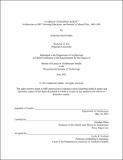"A Great Civilizing Agent": Architecture at MIT, Drawing Education, and Boston's Cultural Elite, 1865-1881
Author(s)
Dubbs, Katherine Pearl
DownloadThesis PDF (69.63Mb)
Advisor
Dutta, Arindam
Terms of use
Metadata
Show full item recordAbstract
This thesis examines the origin of architecture as an American discipline and its relationship to the concurrent promotion of public drawing education in the second half of the nineteenth century. In postbellum Massachusetts, textile manufacturers and their professional networks took control of local drawing education. Part of the perceived antidote to national disunity — as well as a justification for growing financial inequality — was the control of design knowledge through the creation of pedagogical programs and cultural institutions. Drawing simultaneously negotiated a multifarious identity as an industrial skill, a leisure activity, and a specialized profession. Bolstered by the rise in disposable wealth, Boston-based elites invested in drawing as a symbol of class status and industrial control in an increasingly stratified city.
This development coincided with the mid-century emergence of architectural education in American universities. In 1865, architectural educator William Robert Ware was hired to create the architecture department at the Massachusetts Institute of Technology (MIT), the first architecture department in a university and the oldest architecture program in the country. For the duration of his tenure, Ware was part of a powerful network of arts patrons and professionals in Massachusetts who ascribed a civilizing purpose to art, an idealized category which included architecture. As part of this effort, he was not only the founder of MIT’s architecture department but also a founding instructor at two other cultural institutions in Boston. Underpinning these elite ambitions, in Ware’s case, were both economic and intellectual aspirations to elevate architecture as a profession and to cultivate the architect as a cultural connoisseur. This thesis argues that Ware capitalized on the evolving status of drawing –– as a manual labor, a contractual document, a cognitive act, and a cultural marker –– to craft architectural education as an intellectual undertaking worthy of its university setting. This history is illustrated through Ware’s contemporaneous involvement in the promotion of local drawing education, his advocacy for professionalism in architectural education, and his design of new printed material.
Date issued
2021-06Department
Massachusetts Institute of Technology. Department of ArchitecturePublisher
Massachusetts Institute of Technology